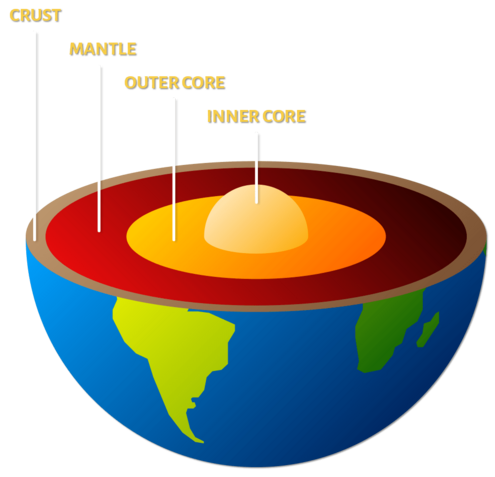POWER of PLATE TECTONICS
Explore how plate tectonics affect our planet.
Structure of Earth
Imagine you could travel from one point on Earth straight through the center of the planet and out the other side. Your journey would be nearly 12,870 kilometers (8,000 miles)!
Along the way, you'd pass through all of Earth's layers:

CRUST
- The rocky surface of Earth is a thin outer shell, much thinner than the other layers.
- The land that we see, or continental crust, is about 30 kilometers (19 miles) thick. Under the sea, oceanic crust is much thinner (8 to 10 kilometers, or 5 to 6 miles thick). But it's also much heavier.
- Earth's crust and the top part of the mantle are broken into ten large plates and many smaller ones.
- Most plates are made of both continental and oceanic crust.
MANTLE
- The crust floats on a thick layer of rock, almost 100 times thicker than continental crust.
- The solid rock isn't like the rock we know. Extreme heat makes it move in circles.
- It flows very, very slowly, but it's enough to cause the plates above it to move over long periods of time.
- The plates move about 8 centimeters (3 inches) per year.
CORE
- The core is even thicker than the mantle.
- It's made up of a liquid metal outer core that flows around a solid metal inner core.
- The motion in the outer core creates a magnetic field around Earth. It's the same field that makes a compass work!
- The core gives off incredible heat, which is one of the driving forces that causes the mantle to flow.
Image Credits:
Layers of Earth, © Vecteezy




 Biodiversity
Biodiversity
 Brain
Brain
 Genetics
Genetics
 Marine BiOLogy
Marine BiOLogy
 MicrobiOLogy
MicrobiOLogy
 PaleontOLogy
PaleontOLogy
 ZoOLogy
ZoOLogy
 AnthropOLogy
AnthropOLogy
 ArchaeOLogy
ArchaeOLogy
 Astronomy
Astronomy
 Climate Change
Climate Change
 Earth
Earth
 Physics
Physics
 Water
Water
